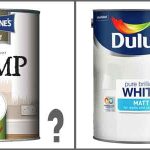The DIY Fix is reader supported. When you buy after clicking a link on our site, we may earn an affiliate commission.

For anybody that has used both oil-based (solvent-based) and water-based paints in the past, you will already know they are different, and you may have a preference to which type you prefer using for certain jobs.
This could be due to the finish they achieve, ease of application, drying times, or even how easy it is to clean your brushes after the job is done.
Like most other types of paint, damp proof paints are available in oil based and water-based varieties. However, oil-based options are far more common.
Whilst oil-based damp paints are more traditional, the paint industry is moving towards more water-based solutions, including damp proof paint options. This is mainly due to water-based paints being more sustainable and better for the environment.
Pros and Cons of oil-based damp proof paints
Below we have listed the pros and cons you might find with an oil-based damp proof paint.
Pros
- Much more variety. If you are looking into damp proof paints, there are no shortage of solvent-based options.
- They can often be used as a stand-alone paint and provide a suitable finished coat, with no need to decorate over
- When applied, the coverage tends to be smooth and the finish can look richer and more vibrant than water-based options.
- Usually, oil-based paints tend to be more durable.
- It may require less coats than a water-based paint to achieve a good quality finish.
- Oil-based paints tend to be better at adhering to chalky, lose, dirty, and damp surfaces. If this is the case, they will usually be your best option.
The paint industry is aware of these advantages. As a result, many companies are working on new formulas to address them, with more sustainable, water-based damp proofing options.
Cons
- Oil based paints are less sustainable and worse for the environment. This includes the manufacturing process. As well as the waste that is caused by unused paints that find there way into land fill. These types of paint contain VOC’s (Volatile organic compounds) that can be harmful to the environment.
- In general oil-based damp proofing paints take much longer to dry.
- They tend to smell quite strong; this can be quite unpleasant and hard to get rid of. It is often one of the biggest complaints you will hear in reviews of this type of product.
- Yellowing is quite common with solvent based paints; this discoloration usually gets worse over time.
- The solvents in these paints are often flammable
- Cleaning brushes and rollers can be messy. For anyone who has worked with oil-based paints, you will already know this. You will need to use solvent-based cleaners such as white spirits to get everything clean.
As you can see, there are several advantages to oil-based damp proof paints. However, there are also some downsides, that could lead you to choose a water-based option.
How do water-based damp proof paints work?
Oil -based paints provide a vapour barrier. This is the reason; they are by far the most common types of damp proof paint. However, many companies have started developing highly effective water-based solutions.
Companies such as Dulux, offer some water-based damp proof paints. One of their most popular products is called Dulux damp seal. This is a water-based product, which contains ingredients to stop damp penetrating through.
However, Dulux damp seal is not intended as a stand-alone damp proofing paint. Instead, it is advised to use it as a primer, or an undercoat. Once applied you can paint over with a standard emulsion. The damp proof undercoat acts as a barrier to stop stains coming through into the finished coat.
Other water-based damp proofing paints contain ingredients, such as styrene-butadiene rubber (SBR) as a waterproofing agent. SBR is commonly used in renders, screeds, and mortars to improve waterproofing properties. It is also commonly used as a primer before applying other damp proofing products, such as tanking slurry.
For these reasons, it is also an effective solution in a water-based damp proof paint.
So, which should you choose? water-based or oil-based?
The type of damp proofing paint you use, will depend on your current situation. It is highly advised that you read other customer reviews, to see where specific products have been successful.
Most products on the market are oil based, and indeed the most popular products do tend to be oil based. This means in most cases it will be the best option.
To learn more about the best damp proofing paints on the market click here


